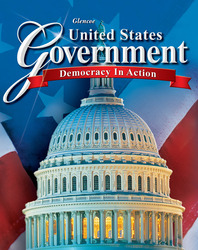United States Government: Democracy in ActionChapter 22:
Policy and DefenseChapter Overviews[logo] Essential Question
How do governments interact with other nations? How do the choices made by these nations affect their citizens? Section 1 Development of Foreign Policy
The principal goal of U.S. foreign policy is to preserve the security of the United States. Other goals include maintaining trade with other nations and preserving access to necessary natural resources. U.S. leaders try to help other nations settle disputes and supply economic aid to countries in danger of uprisings. The United States also helps victims of natural disasters or starvation. The United States held an isolationist policy early in its history. The Monroe Doctrine even warned European powers away from the Western Hemisphere in 1823. When the United States became an industrial power in the 1890s, however, it needed resources and markets and began to expand and colonize. The Spanish-American War in 1898 gave the country the Philippine Islands, Guam, and Puerto Rico. Hawaii and Samoa were next. World War I and World War II pulled the United States away from neutrality, and the country emerged as the leader of the world's free nations. This new role brought it into conflict with the Soviet Union during the Cold War. As it tried to contain communism, the United States gave aid to other countries, began stockpiling nuclear weapons, and was drawn into conflicts in Korea and Vietnam. The post-Cold War era brought new challenges of maintaining peace, building democracy, promoting global trade, maintaining stability in the Middle East to protect the world's oil supplies, and helping Eastern Europe make the transition to democracy. Section 2 Shared Foreign Policy Powers
The Constitution divides the responsibility for foreign affairs between the president and Congress. The president directs U.S. foreign policy and is commander in chief of the nation's military forces. The president also appoints ambassadors and makes treaties. The Department of State and the Department of Defense aid the chief executive in diplomacy and military activities. Other agencies involved in foreign policy include the National Security Council, the Central Intelligence Agency, and other groups in the "intelligence community." Congress plays a significant role in foreign policy through its power to declare war and appropriate money. Instead of requesting a formal declaration of war, presidents sometimes ask Congress to pass a joint resolution concerning the use of American troops. The Senate must ratify treaties and confirm diplomatic appointments. Increasingly, presidents have turned to executive agreements instead of treaties to make pacts with leaders of other nations. Although Congress has the power to block presidential foreign policy actions, it usually lets the president set a direction in foreign policy. Public opinion and interest groups influence foreign policy as well. Section 3 State and Defense Departments
In the executive branch, two departments are mainly responsible for foreign policy. The Department of State's primary goals are to "promote the long-range security and well-being of the United States," to keep the president informed about international issues, to maintain diplomatic relations with foreign governments, to negotiate treaties with foreign governments, and to protect the interests of Americans who are traveling or conducting business abroad. Six assistant secretaries direct six geographic bureaus of the State Department. Other bureaus analyze information about specific foreign policy topics, such as educational and cultural affairs. More than half of the employees of the State Department serve in other countries as embassy officials or in consulates. The Department of Defense supervises the armed forces of the United States and makes sure these forces are strong enough to defend U.S. interests. Congress determines how much money the Defense Department will spend each year. With more than 700,000 civilian employees and more than 1 million military personnel on active duty, the Department of Defense is the largest executive department. It is headquartered in the Pentagon. Among its major divisions are the Departments of the Army, Navy, and Air Force. The U.S. Marine Corps, under the jurisdiction of the Navy, maintains separate leadership. The Joint Chiefs of Staff advise the president, the National Security Council, and the secretary of defense. Section 4 Foreign Policy in Action
The tools of U.S. foreign policy include alliances, foreign aid, economic sanctions, and military action. The United States has signed mutual defense treaties with nations in Western Europe, the North Atlantic, Central and South America, and island nations of the south Pacific. NATO arose in Western Europe during the Cold War but has expanded its mission to include crisis intervention and peacekeeping in other areas of the world. The Rio Pact is a multilateral treaty among Latin American nations and the United States. The United States has alliances with almost 50 nations, which can count on the military support of the United States in case of an attack. Economic aid is another type of support that U.S. leaders provide. The Agency for International Development dispenses loans and technical assistance. The withdrawal or denial of benefits through sanctions or the withdrawal of trade is a third diplomatic strategy. In addition, military force, or the threat of force, has always been an important tool of U.S. foreign policy.  | 
















